Are you curious about the Brazilian wildlife? Then this list with the 31 most iconic animals in Brazil will blow your mind!
With continental proportions, Brazil is the world’s most biodiverse country.
We proudly are home to (part of) the world’s largest rainforest (the Amazon), the world’s largest tropical wetland (the Pantanal), and a range of terrestrial and aquatic ecosystems.
These habitats are obviously rich in Brazilian wildlife, making the country rank first in plant and amphibian species counts, second in mammals, and third in birds, reptiles, and fish.
With that in mind, there is no better way to celebrate and spread the word about the vast diversity of Brazilian animals than compiling a comprehensive list of some iconic animals of Brazil.
This article is especially appealing for children, so you might want to share it with a little one in the family so s/he can learn more about Brazil.
Mind you, I will talk about Brazilian animals as well as animals found in Brazil (but that are native to the Amazon region, which sprawls over a few countries).
Ok, so before we dive into Brazil wildlife, let me answer a few frequently asked questions.
What animals live in Brazil?
Brazil’s wildlife is highly diverse as it is home to varied sorts of birds, mammals, reptiles, amphibians, and more.
Some of the most notorious animals from Brazil are the jaguar, capybara, giant anteater, yellow armadillo, maned wolf, and toco toucan.
Amazon Rainforest fact: The Amazon has more animal species than anywhere else in the planet.
How many species of animals are in Brazil?
It’s difficult to give an exact answer, but it’s estimated Brazilian species account for 9.5% of the world total, namely between 170,000 to 210,000.
Do giraffes live in Brazil?
It’s a common misunderstanding, but unless in captivity, there are no giraffes in Brazil.
Are there tigers in Brazil?
No, tigers are notorious Asian animals. Brazil’s big cat is the jaguar.
What is the most dangerous animal in Brazil?
While many people consider the anaconda and piranha the most dangerous animal in Brazil, it is rare to see any accidents involving them and humans. Still, the Brazil-nut poison frog would be the most dangerous animal upon contact.
What is the most common animal in Brazil?
The capybara is probably the most common animal in Brazil since you can spot it not only in the forests but also in the cities.
What’s Brazil’s Big Five?
Brazil’s Big Five are the jaguar, giant armadillo, Brazilian tapir, giant anteater, and the maned wolf.
What’s the national animal of Brazil?
Of all national symbols of Brazil, the national animal is the only one with no consensus. Still, the Rufous-bellied thrush is the national bird of Brazil, which was officially determined by a presidential decree.
However, the mainstream media often represents the country using the hyacinth macaw or the jaguar, both Brazilian animals.
Note to spotting animals
If you attempt to spot these animals in the wild, please, don’t feed or approach them. It’s vital they are and feel safe. It’s a fact we humans have caused more harm than good to the wildlife, so let’s do our part in preserving them.
Read up on wildlife photography, buy decent gear, and keep your distance. Thank you!!
Incredible animals found in Brazil
These are the most iconic animals from Brazil in no particular order. Enjoy!
1. Giant otter
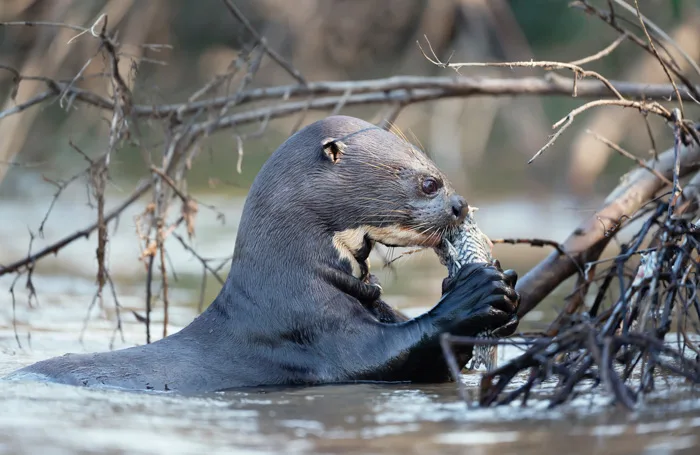
Of all the rainforest animals in Brazil, the giant otter is one of the most vulnerable species due to hunting.
- Scientific name: Pteronura brasiliensis
- Class: Mammal
- Size and appearance: Up to 6 feet (183 cm). They have a chocolate brown, sometimes reddish, fur that is very dense, maintaining the skin dry. They also have a white mark on the throat, which the animals use to identify one another. Beyond that, the giant otters have a short muzzle and ball-shaped head.
- Weight: About 75 pounds (34 kg).
- Lifespan in the wild: 10 to 13 years
- Conservation status: Endangered, meaning this animal species are at very high risk of extinction in the wild, according to the IUCN Red List of Threatened Species.
- Threats: Poaching for fur trading, together with habitat destruction and degradation, leads to a severe decrease in the giant river otter population.
- Hunting and diet: These Amazon Rainforest mammals are close to being apex predators, hunted only by the jaguar, caiman, and anaconda. These otters hunt alone or in groups, and fish, including the piranha, make up most of their diet.
- Best places to see giant otters: Giant otters live in the Amazon Rainforest rivers and creeks.
2. Brazilian ruby
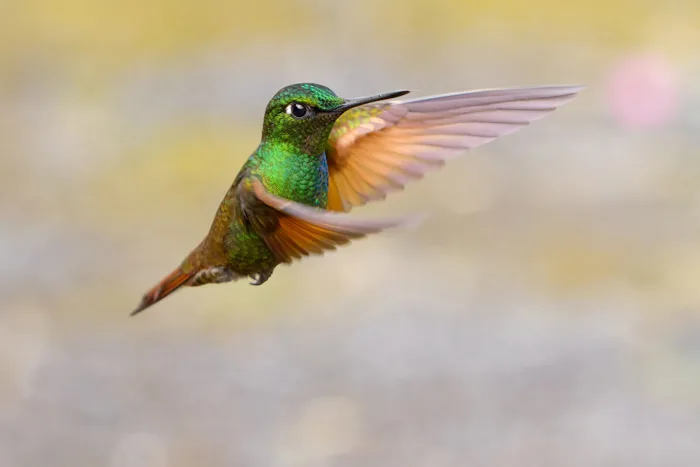
The Brazilian ruby is a relatively large hummingbird, and it is the only species placed in the genus Clytolaema.
- Scientific name: Clytolaema rubricauda
- Class: Bird
- Size and appearance: Body length, 4 to 6 inches (10 to 11.5 cm). The males are green with a coppery back and rump and a reddish tail and throat. In contrast, the females are green above and cinnamon below.
- Weight: 0.25 to 0.32 ounces (7 to 9 gr).
- Lifespan in the wild: 12 to 15 years
- Conservation status: Least concerned, meaning the Brazilian ruby is at relatively low risk of extinction, according to the IUCN Red List of Threatened Species.
- Threats: Unknown.
- Hunting and diet: They feed primarily on nectar from flowers of trees, herbs, and shrubs. They use their straw-like tongue to retrieve the nectar licking it up to 13 times per second.
- Best places to see Brazilian ruby: They are usually found in forest edges and parks in eastern Brazil, such as Paraty, a town in Rio de Janeiro State with popular birdwatching tours.
3. Giant anteater
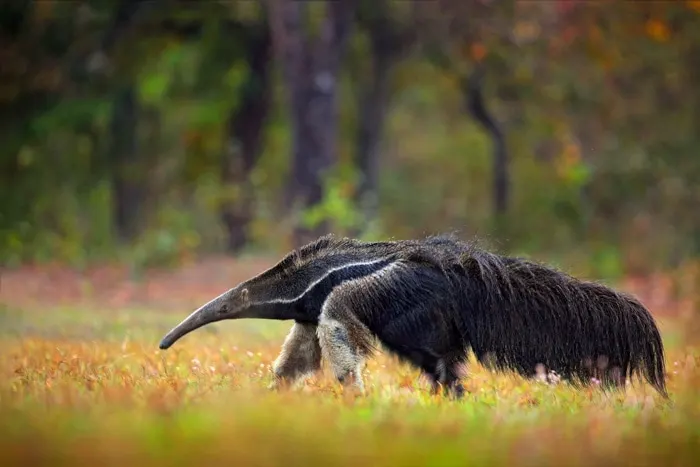
These big edentate animals swallow about 35,000 ants and termites every day. Beyond that, this Brazilian animal is not aggressive, but it can be fierce. It has 4 in/10 cm long claws and can fight off predators, such as the jaguar.
- Scientific name: Myrmecophaga tridactyla
- Class: Mammal
- Size and appearance: Head and body, 6 to 49 inches (15 to 125 cm); tail, 7 to 35 inches (18 to 89 cm). The giant anteaters have no teeth, only a long tongue to lap up thousands of ants every day. They are covered in grayish-brown fur with white front legs, black stripes running from the chest to the back, and a bushy tail.
- Weight: 40 to 140 pounds (18 to 63 kg).
- Lifespan in the wild: 14 years
- Conservation status: Vulnerable, meaning the giant anteater is at high risk of extinction in the wild, according to the IUCN Red List of Threatened Species.
- Threats: The development of urban areas, agriculture, poaching, road traffic, and natural system modifications, as in forest fires, contribute to the decreasing population of the giant anteater.
- Hunting and diet: The giant anteaters use their sharp claws to tear an opening into an anthill and flicks their long tongues into the whole up to 150 times per minute. Because the ants fight back with painful stings, the anteaters only feast for about a minute before moving on. Also, they never destroy the nest, so they have a place to feed later.
- Best places to see giant anteaters: You can spot them in forests, open grasslands, and savannas, such as the Brazilian Cerrado, a vast tropical savanna ecoregion, particularly in the states of Goiás, Mato Grosso do Sul, Mato Grosso, Tocantins, Minas Gerais, and the Federal District.
4. Ocelot
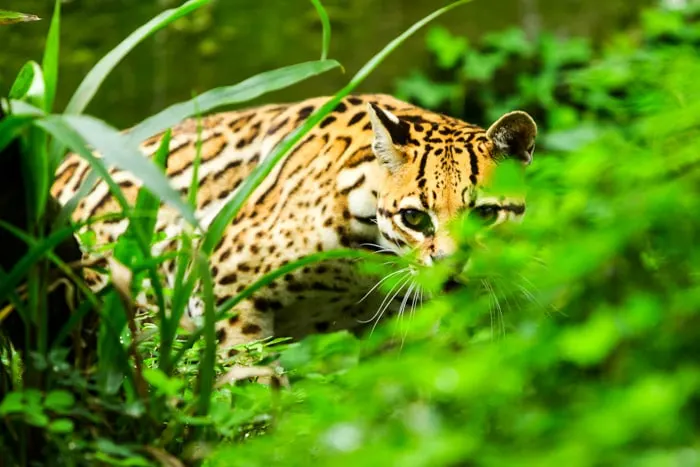
These nocturnal cats are known for having a solitary life within a home range of as much as 4,200 soccer fields.
- Scientific name: Leopardus pardalis
- Class: Mammal
- Size and appearance: 28 to 35 inches (71 to 89 cm). Ocelots are sleek animals with a gorgeous dappled coat and are twice the average house cat’s size. Namely, their body is covered with solid black markings on a creamy, tawny, yellowish, reddish-gray, or gray fur.
- Weight: 24 to 35 pounds (11 to 16 kg).
- Lifespan in the wild: 10 to 13 years
- Conservation status: Least concerned, meaning the ocelot is at relatively low risk of extinction, according to the IUCN Red List of Threatened Species.
- Threats: Urban development, agriculture, mining, road traffic, hunting, recreational activities, and pollution are some of the reasons the ocelot population is decreasing.
- Hunting and diet: These nocturnal cats usually hunt iguanas, fish, frogs, rabbits, and rodents, but they also climb trees to stalk monkeys and birds. Like the jaguar, the ocelot can swim well.
- Best places to see ocelots: Ocelots live in the Amazon Rainforest, but they also inhabit brushlands going as far north as Texas, United States.
5. Common marmoset
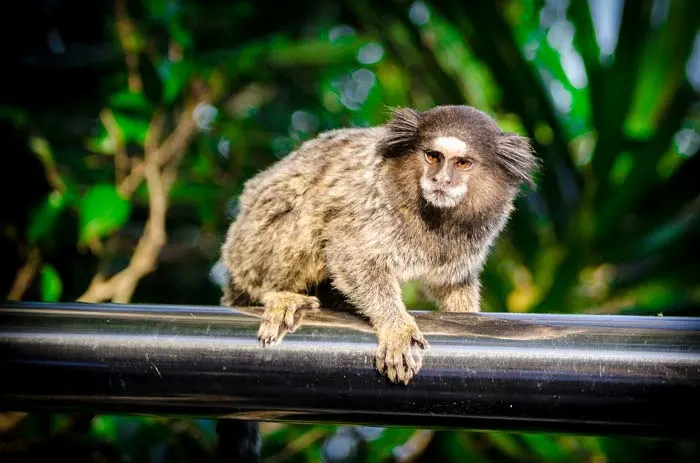
The common marmosets are unique primates with a rather unusual appearance and several particular adaptations that inhabit the Brazilian coastal Atlantic forest.
- Scientific name: Callithrix jacchus
- Class: Mammal
- Size and appearance: About 7 inches (18 cm) high. Common marmosets are tiny monkeys with relatively long tails. The pelage of the marmoset is multicolored, being sprinkled with brown, gray, and yellow. It also has white ear tufts, and the tail is banded.
- Weight: around 9 ounces (255 gr).
- Lifespan in the wild: 4 to 6 years
- Conservation status: Least concern, meaning it has a relatively low risk of extinction.
- Threats: Agriculture and hunting are the main threats to this Brazilian monkey.
- Hunting and diet: The marmosets use their claw-like nails to cling to tree trunks and chew a hole in them. The monkeys will then lick up the exudates. Besides, they also eat insects.
- Best places to see marmosets: The marmosets are one of the cutest wild animals native to Brazil. They live in forests in the states of Piauí, Ceará, Rio Grande do Norte, Pernambuco, Alagoas, Paraíba, and Bahia. They became an invasive species in Rio de Janeiro in 1929, and live in the Atlantic Forest around the state, for instance, the Sugarloaf Mountain and Tijuca National Park.
6. Maned wolf
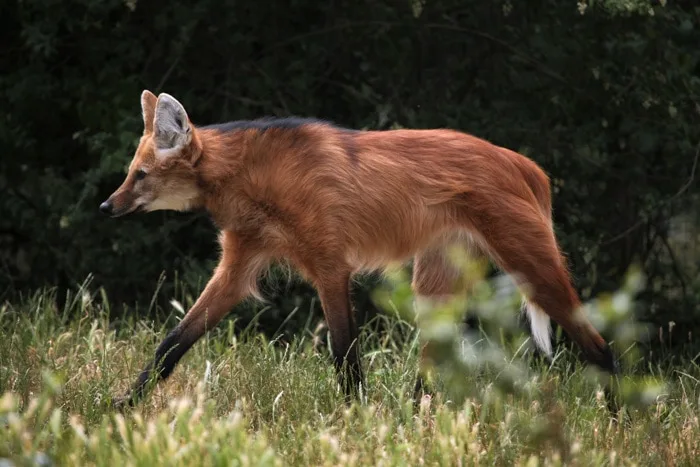
The Maned wolf gets its name from its mane, which stands erect when danger is sensed.
- Scientific name: Chrysocyon brachyurus
- Class: Mammal
- Size and appearance: Head-body length of 39 inches (99 cm) with the tail adding another 18 inches (45 cm). It is about 35 inches (89 cm) at the shoulders. As the largest canine found in Brazil, let alone South America, the maned wolf is reddish-brown to golden orange with long black legs and a distinctive black mane.
- Weight: 44 to 73 pounds (20 to 33 kg).
- Lifespan in the wild: Unknown, but in captivity, 12 to 15 years
- Conservation status: Near threatened, meaning the maned wolf is likely to become vulnerable soon, according to the IUCN Red List of Threatened Species.
- Threats: Agriculture, road traffic, and illegal hunting are some of the reasons why the maned wolf is a near threatened animal in Brazil and the world.
- Hunting and diet: The maned wolf avoids hunting during the daytime unless it’s cold and cloudy. This solitary wolf hunts alone and uses its large ears to listen for prey animals in the grass.
- Best places to see maned wolves: These animals prefer to live in grasslands, scrub prairies, forests, and savannas, such as the Brazilian Cerrado. That’s why the maned wolf became the flag species for the preservation of this region in Brazil. Beyond that, the wolf is also represented on the 200 reais banknote.
7. Capybara
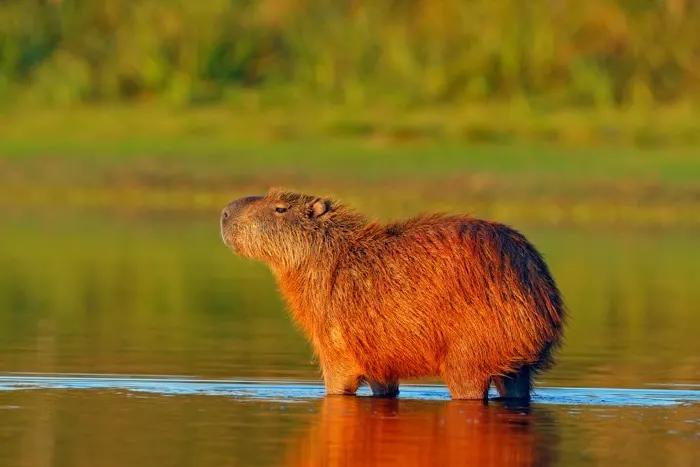
The world’s largest rodent, the massive Capybara is as heavy as an adult human.
As a matter of fact, the word ‘capybara’ is believed to mean ‘master of the grasses’, whereas the scientific name of this species means ‘water hog’ in Greek.
- Scientific name: Hydrochoerus hydrochaeris
- Class: Mammal
- Size and appearance: About 4.6 feet (140 cm) long and up to 2 feet (60 cm) high at shoulders. With a barrel-shaped body, short head, and reddish-brown fur, the capybara is the world’s largest rodent.
- Weight: 77 to 143 pounds (35 to 65 kg).
- Lifespan in the wild: up to 10 years
- Conservation status: Least concern, meaning it has a relatively low risk of extinction.
- Threats: Hunting and road traffic are the main threats to the capybara.
- Hunting and diet: Capybaras feed mainly on grasses, aquatic plants, fruit, and tree bark. The capybaras’ jaw hinge is not perpendicular, so they chew food by grinding back-and-forth rather than side-to-side. These wild animals are often prey for jaguars, pumas, ocelots, caimans, and green anacondas.
- Best places to see capybara: While you can spot capybaras along rivers in many cities throughout Brazil, such as São Paulo, you can also spot them in the Amazon Rainforest.
8. Crab-eating fox
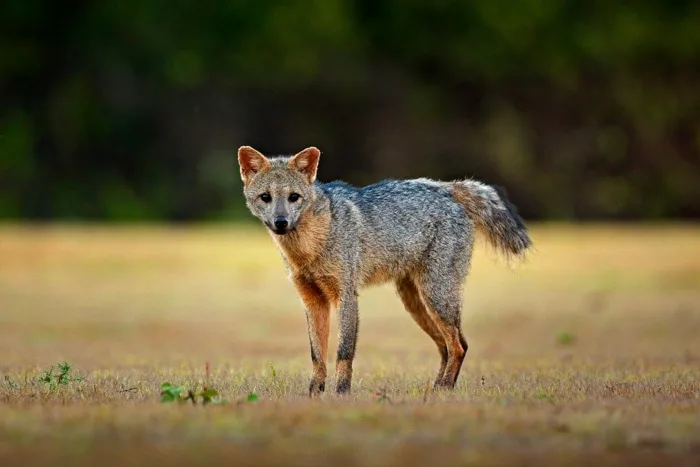
The Crab-eating fox is mainly nocturnal and is also active during dusk, spending the day in a den dug by other animals.
- Scientific name: Cerdocyon thous
- Class: Mammal
- Size and appearance: Head and body, 25 inches (63 cm); tail, 11 inches (28 cm). The crab-eating fox is predominantly greyish-brown, with red areas on the face and legs and black-tipped ears and tail. It has short, strong legs, and its tail is long and bushy.
- Weight: 10 to 17 pounds (5 to 8 kg).
- Lifespan in the wild: 11 years
- Conservation status: Least concerned, meaning the ocelot is at relatively low risk of extinction, according to the IUCN Red List of Threatened Species.
- Threats: At the moment, invasive non-native species and diseases are the main threats for the crab-eating fox.
- Hunting and diet: These foxes search for crabs and crustaceans on muddy floodplains during the wet season and insects in the dry season. They also hunt rodents, birds, tortoises, fruit, eggs, and lizards.
- Best places to see crab-eating foxes: While these foxes live in northern and central South America, their strongholds are the woodlands and tropical savannas between the Amazon Rainforest and the Atlantic Ocean. It goes from Rio Grande do Norte, Tocantins, Bolivia, Uruguay, and all coastal towns along the Brazilian coast.
9. Southern tamandua
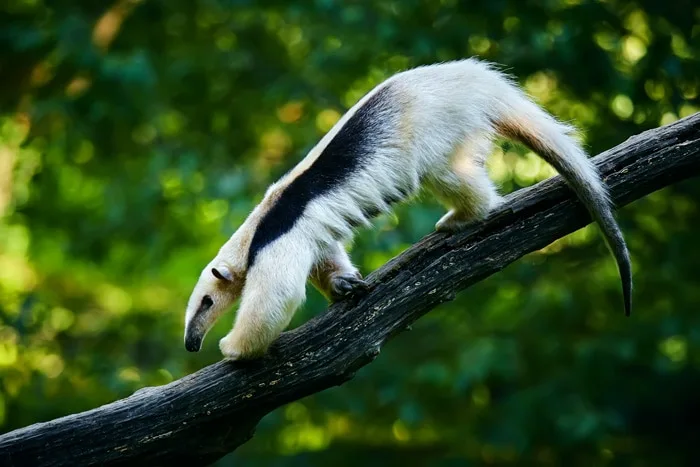
The Southern tamandua is a unique anteater, which is equally arboreal and terrestrial. This animal is nicknamed ‘lesser anteater’ due to being smaller than the related giant anteater.
- Scientific name: Tamandua tetradactyla
- Class: Mammal
- Size and appearance: Head and body, 13 to 35 inches (33 to 89 cm); tail, 15 to 26 inches (38 to 66 cm). It has four clawed digits on the forefeet and five on the hind feet. The snout is long and decurved with an opening only as wide as the stick’s diameter, from which the 16-inch tongue is protruded.
- Weight: 3 to 17 pounds (1.4 to 8 kg).
- Lifespan in the wild: 9 years
- Conservation status: Least concern, meaning it has a relatively low risk of extinction.
- Threats: Agriculture, hunting, natural fires, and road traffic are the main threats to the Southern tamandua.
- Hunting and diet: The southern tamanduas eat ants and termites but also eat a small amount of fruit.
- Best places to see southern tamanduas: These wild animals usually live in tropical forests, mangroves, and savannas, such as the Brazilian Pantanal.
10. Golden lion tamarin
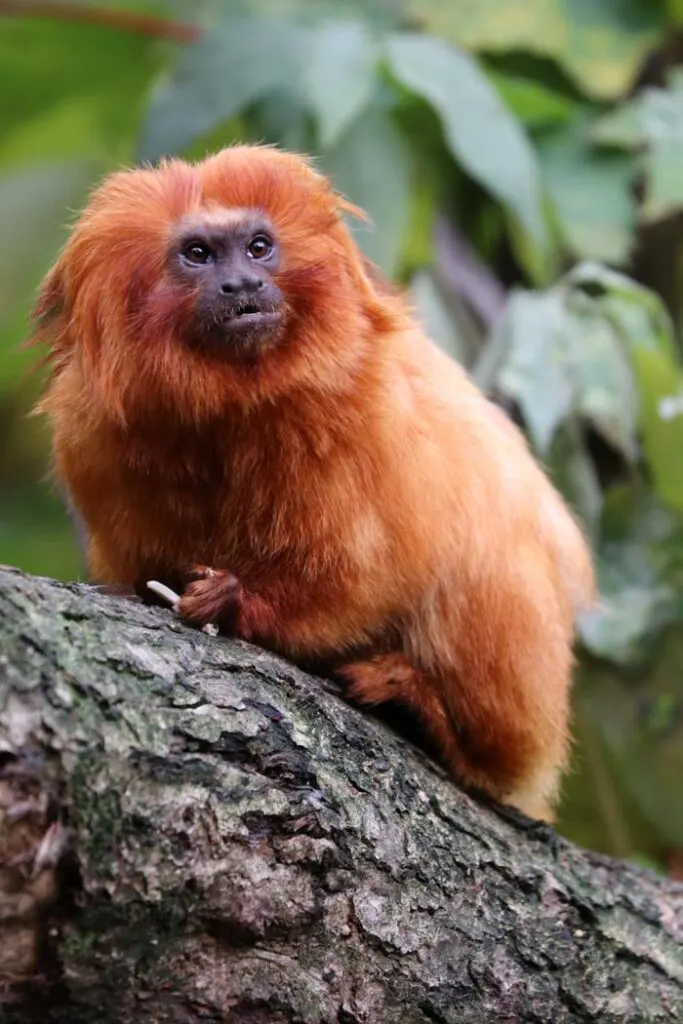
The Golden lion tamarin is a small, endangered primate endemic to the Atlantic coast of Brazil. Despite its name, this monkey isn’t related to lions.
- Scientific name: Leontopithecus rosalia
- Class: Mammal
- Size and appearance: Head and body, 7.5 to 8.75 inches (19 to 22 cm); tail, 10.25 to 13.5 inches (26 to 34 cm). It has a bright reddish-orange pelage and extra long hairs around the face.
- Weight: 14 to 29 ounces (396 to 822 gr).
- Lifespan in the wild: 15 years
- Conservation status: Endangered, meaning it has a very high risk of extinction in the wild, according to the IUCN Red List of Threatened Species.
- Threats: Ever-expanding lodging, agriculture, natural fire, and road traffic are the main threats to the golden lion tamarin.
- Hunting and diet: These monkeys eat fruits, flowers, nectar, bird eggs, insects, and small vertebrates.
- Best places to see golden lion tamarins: These monkeys have a minimal distribution range. They live in the tropical rain forests of Rio de Janeiro, including Cabo Frio and Arraial do Cabo.
11. Azara’s agouti
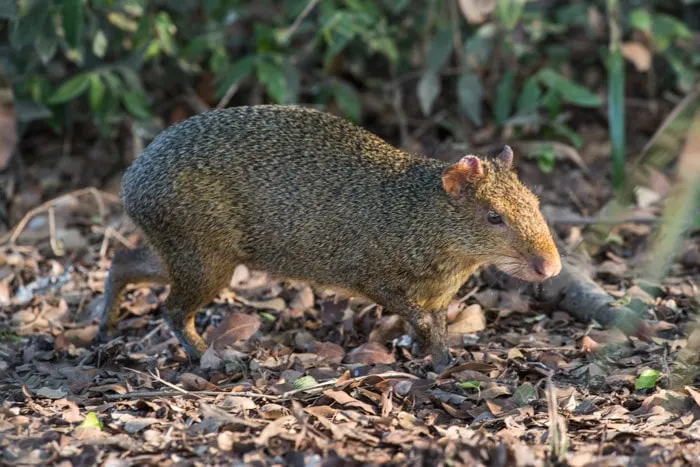
Resembling the red squirrels in Europe, Azara’s agoutis are rodents named after Spanish naturalist Félix de Azara.
- Scientific name: Dasyprocta azarae
- Class: Mammal
- Size and appearance: Body length, 16 to 24 inches (41 to 62 cm); tail, 1.6 to 4 inches (10 to 25 cm). This rodent has speckled brown fur with a lighter-toned underside. It also has five toes on its front feet and only three toes on its hind feet.
- Weight: 3 to 9 pounds (1.3 to 4 kg).
- Lifespan in the wild: up to 20 years
- Conservation status: Not evaluated.
- Threats: The population is unknown and may have gone locally extinct in some areas due to hunting.
- Hunting and diet: Azara’s agoutis are herbivores. They feed on plant material, fruits, seeds, and nuts. They are also known as one of the only animals that can open a Brazil nut unaided, using their exceptionally sharp teeth and jaw strength.
- Best places to see Azara’s agoutis: You can spot these lovely rodents in the Brazilian Pantanal and Iguazu Falls.
12. South American coati
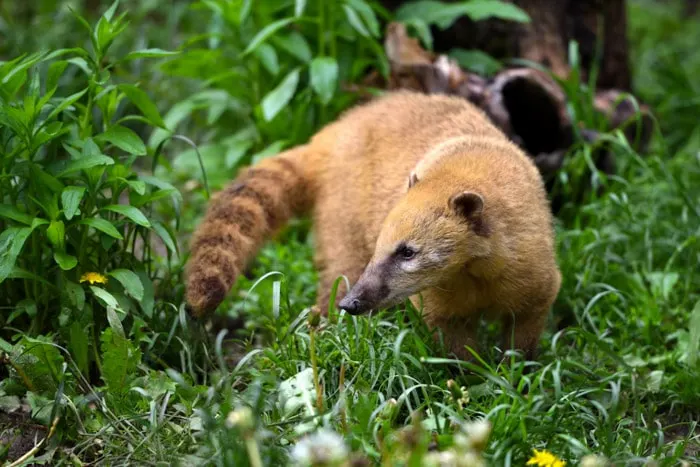
The South American coati, also known as the coatimundi, is a member of the raccoon family.
- Scientific name: Nasua nasua
- Class: Mammal
- Size and appearance: Body length, 34 to 45 inches (85 to 113 cm). Their coat can be brown, gray, red, and whitish. The snout is elongated and dark, while the tail is brown with yellow rings.
- Weight: 4.4 to 15 pounds (2 to 7 kg).
- Lifespan in the wild: 7 to 14 years
- Conservation status: Least concerned, meaning the South American coati is at relatively low risk of extinction, according to the IUCN Red List of Threatened Species.
- Threats: Wood harvesting, ever-evolving lodging, hunting, and livestock farming are threats to the South American Coati.
- Hunting and diet: They feed on fruit, beetles, scorpions, spiders, lizards, rodents, chickens, other small animals, and bird eggs.
- Best places to see South American coatis: They typically live in the Pantanal and the Atlantic forest, like the Iguazu Falls.
13. Bush dog
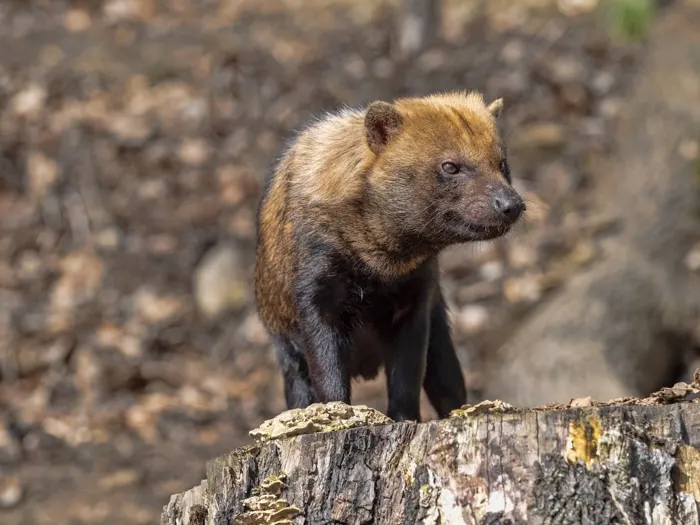
This Brazilian animal is so rare that in the past, it was thought to be extinct. They were first discovered using fossil records in caves in Brazil, and, having never been seen before this, it was thought they no longer existed.
- Scientific name: Speothos venaticus
- Class: Mammal
- Size and appearance: Head and body, 22 to 29 inches (56 to 74 cm); tall, 8 to 12 inches (20 to 30 cm). The bush dog has a squat body, long, reddish-brown fur, and webbed feet.
- Weight: 13 pounds (6 kg).
- Lifespan in the wild: 10 years
- Conservation status: Near threatened, meaning it is likely to become vulnerable soon, according to the IUCN Red List of Threatened Species.
- Threats: Ever-expanding lodging, agriculture, hunting, and invasive non-native species are the bush dog’s main threats.
- Hunting and diet: Bush dogs are carnivores, and they prey mostly on agoutis, capybaras, pacas, and acouchis. Bush dogs are monogamous and live in extended family groups.
- Best places to see bush dogs: This dog lives in semi-deciduous forests, lowland forests, seasonally flooded forests, and wet savannas, such as the Brazilian Pantanal.
14. Tufted capuchin
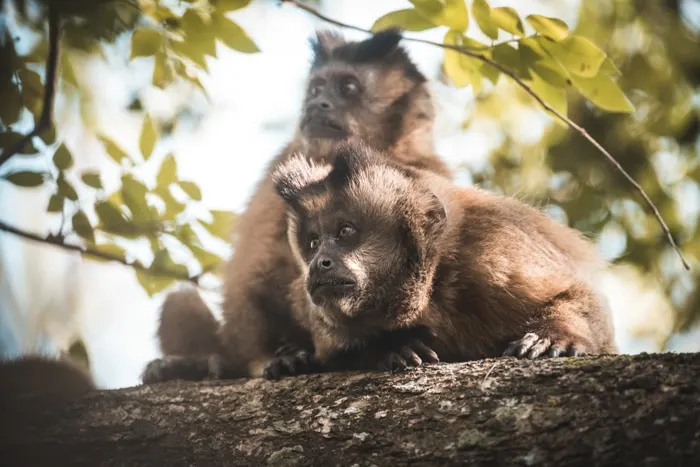
The tufted capuchin is named after friars dressed in brown robes with hoods covering their heads. These animals are curious and tend to play with anything they find.
- Scientific name: Sapajus apella
- Class: Mammal
- Size and appearance: Head and body, 13 to 22 inches (33 to 56 cm); tail, 15 to 22 inches (38 to 56 cm). Also known as Margarita Island capuchins, the tufted capuchin is brownish gray, while its belly is slightly lighter-colored. It has a rougher fur and a long, thick tail.
- Weight: 4 to 10 pounds (1.8 to 4.5 kg).
- Lifespan in the wild: 15 to 25 years
- Conservation status: Least concern, meaning it has a relatively low risk of extinction.
- Threats: Ever-expanding lodging, agriculture, natural fire, hunting, and road traffic are the main threats to the tufted capuchin.
- Hunting and diet: The tufted capuchin diet relies heavily upon eggs, insects, pith, small mammals, birds, squirrels, small reptiles, nuts, and nectar. In addition to other small mammals, tufted capuchins are a confirmed predator of the titi monkey.
- Best places to see tufted capuchins: These New World monkeys are widespread across several Latin American countries, including Bolivia, Brazil, French Guiana, Guyana, Peru, Suriname, and Venezuela. In Brazil, it can be found in the Amazon Basin.
15. Pink dolphin
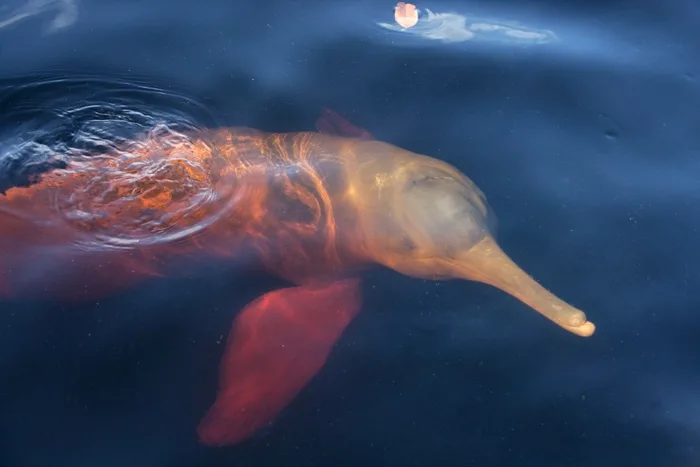
The Amazon River dolphin, also called the Boto or pink dolphin, is one of the five river dolphins and is treated with suspicion by local people.
In Brazilian folklore, these animals become handsome men to seduce young women into the water.
- Scientific name: Inia geoffrensis
- Class: Mammal
- Size and appearance: Up to 9 feet (274 cm). The pink river dolphins are the largest freshwater dolphins in the world. Its color varies with age. Newborns are usually dark gray, becoming light gray during adolescence, and pink as adults. Males are often pinker than females.
- Weight: 300 pounds (136 kg).
- Lifespan in the wild: Unknown. In captivity, 10 to 30 years.
- Conservation status: Endangered, meaning it has a very high risk of extinction in the wild, according to the IUCN Red List of Threatened Species.
- Threats: Ever-expanding lodging, mining, fishing, human intrusions, harmful tourism, and pollution are the main threats to the Amazon River dolphin.
- Hunting and diet: It eats many fish species, such as piranha and tetras. But it also feeds from river turtles and freshwater crabs. They depend much more on their sense of echolocation than vision when navigating in these rivers’ murky waters.
- Best places to see pink dolphins: This giant species of freshwater dolphin swims in the Amazonian rivers’ waters.
16. Toco toucan
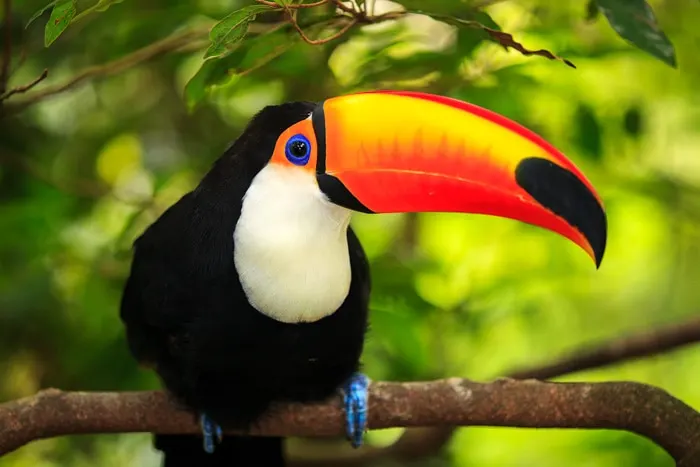
The Toco toucan is the largest and probably the best-known species in the toucan family. Its bill is amongst the largest of any animal.
- Scientific name: Ramphastos toco
- Class: Bird
- Size and appearance: Body length, 21 to 25 inches (53 to 63 cm); bill, up to 9 inches (23 cm). The toco toucan is the largest species in the toucan family. These birds have black feathers and a white throat and face, while their eyes are surrounded by blue and orange skin. Their bills are yellow-orange with a black base and a large spot on the tip.
- Weight: 1 to 2 pounds (0,5 to 0,9 grams).
- Lifespan in the wild: 18 to 26 years
- Conservation status: Least concern, meaning it has a relatively low risk of extinction.
- Threats: Unknown.
- Hunting and diet: Toco toucans are omnivores, meaning they feed mainly on fruits, berries, nuts, insects, frogs, small reptiles, small birds, and bird’s eggs.
- Best places to see toco toucans: Toco toucans are typically found in woodlands, grasslands, and savannas. You can spot them in the Iguazu (and northern Argentina), and the Brazilian Pantanal in Mato Grosso do Sul State, and in the Cerrado in Goiás, Tocantins, and part of Minas Gerais and Mato Grosso states.
17. Yellow armadillo
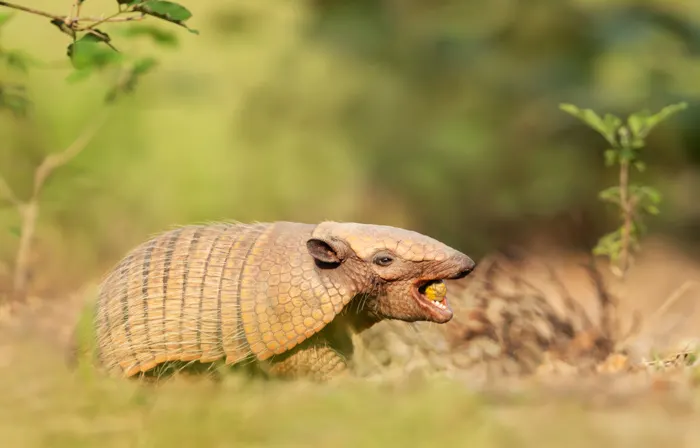
Also known as the six-banded armadillo, this species is the third-largest armadillo after the giant armadillo and the greater long-nosed armadillo.
- Scientific name: Euphractus sexcinctus
- Class: Mammal
- Size and appearance: Head and body, 16 and 20 inches (40 to 51 cm); tail, 4.7 to 9.4 inches (12 to 24 cm). The carapace is pale yellow to reddish-brown (though not a dark shade of brown or black), marked by scales of equal length, and scantily covered by buff to white bristle-like hairs – unlike the hairy armadillos that are covered by dense hairs.
- Weight: 7 to 14 pounds (3.2 to 6.5 kg).
- Lifespan in the wild: 8 to 12 years
- Conservation status: Least concern, meaning it has a relatively low risk of extinction.
- Threats: Hunting.
- Hunting and diet: The yellow armadillo is an omnivore that feeds on small invertebrates, insects, ants, fruits, carrion, palm nuts, and tubers.
- Best places to see yellow armadillos: This species inhabits forest, shrublands, and cerrado, the Brazilian savanna in the states of Maranhão, Tocantins, Goiás, Mato Grosso do Sul, and part of Minas Gerais and Mato Grosso.
18. Peach-fronted parakeet
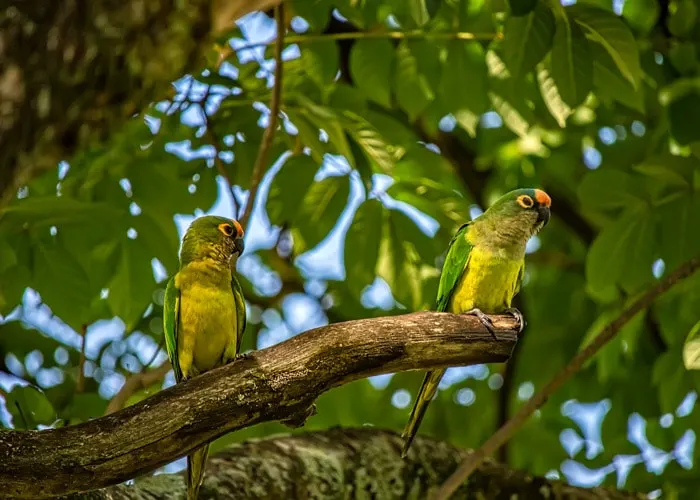
Distinctive and very noisy parakeet, the peach-fronted parakeet usually lives in woodlands, savannas, and agricultural areas, often venturing into urban areas too.
- Scientific name: Eupsittula aurea
- Class: Bird
- Size and appearance: Up to 10 inches (25 cm). This bird native to Brazil has a grayish-greenback with a lighter green color on the breast. The forehead and part of the crown are peach colored, while the rest of the crown is blue-green.
- Weight: Up to 3.7 ounces (105 gr).
- Lifespan in the wild: 12 to 15 years
- Conservation status: Least concern, meaning it has a relatively low risk of extinction.
- Threats: Unknown.
- Hunting and diet: These Brazilian birds eat seeds, flowers, and insects only.
- Best places to see peach-fronted parakeet: These parrots inhabit woodlands, savannas, and cultivated areas. You can easily spot them in the Brazilian Pantanal.
19. Brazilian tapir
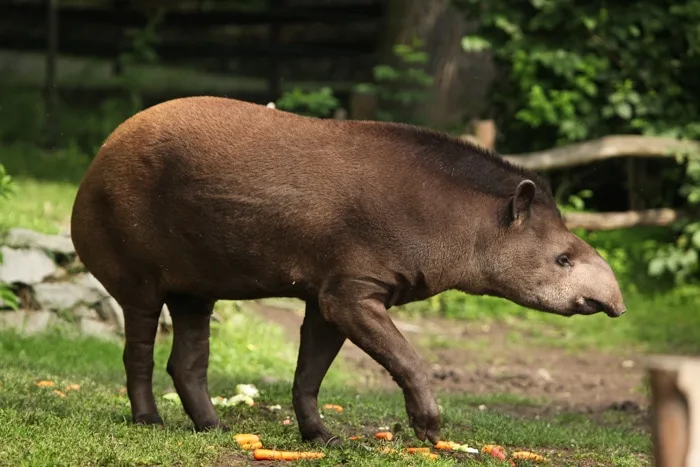
Brazilian tapir is a species of rhinoceros family and was recognized as a separate species in 1758.
Newborn babies exhibit dappled spots on their bodies, which serve as ideal camouflage. These markings disappear by six months old, after which the young tapirs gain their adult appearance.
- Scientific name: Tapirus terrestris
- Class: Mammal
- Size and appearance: Body length, 6 to 8 feet (180 to 250 cm); height, 2.5 to 3.5 feet (77 to 108 cm). Brazilian tapir is a species of the rhinoceros family with a characteristic fleshy trunk, which serves as a snorkel when the tapir swims, and it has a dark brown coat.
- Weight: 330 to 705 pounds (150 to 320 kg).
- Lifespan in the wild: 30 to 35 years
- Conservation status: Vulnerable, meaning the Brazilian tapir is at high risk of extinction in the wild, according to the IUCN Red List of Threatened Species.
- Threats: Habitat loss, agriculture, wood harvesting, and hunting are the main reasons this animal is at high risk of extinction.
- Hunting and diet: This mammal feeds on fruits, leaves, flowers, and shoots.
- Best places to see Brazilian tapirs: The best place to spot these gentle relatives of rhinoceros in the wild is the Pantanal, especially Pouso Alegre eco-lodge.
20. Electric eel
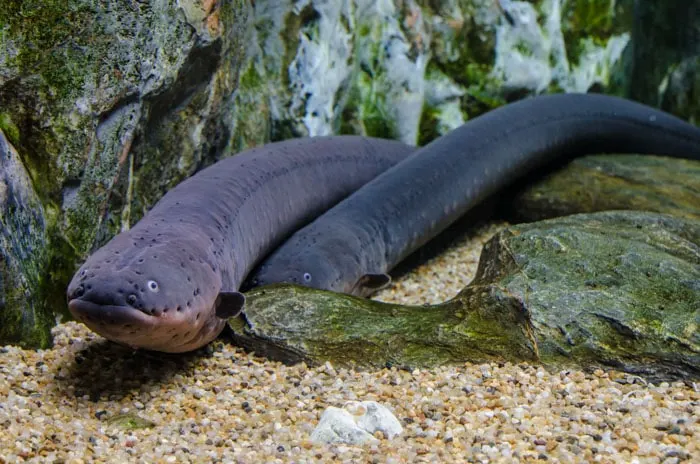
Electric eels can produce shocks of up to 600 volts, that’s enough to knock a horse off its feet. While they are not a threat to humans, multiple shocks can cause respiratory and heart failure.
- Scientific name: Electrophorus electricus
- Class: Fish
- Size and appearance: Body length, 6 to 8 feet (183 to 244 cm). Despite their serpentine appearance, electric eels are not actually eels, but their scientific classification is closer to carp and catfish. They have long, cylindrical bodies and flattened heads and are generally dark green or grayish on top with yellowish coloring underneath.
- Weight: 44 pounds (20 kg).
- Lifespan in the wild: 15 years
- Conservation status: Least concerned, meaning the South American coati is at relatively low risk of extinction, according to the IUCN Red List of Threatened Species.
- Threats: Fishing is currently the main threat to the electric eel.
- Hunting and diet: This electric catfish feeds on fish, amphibians, small birds, and small mammals.
- Best places to see electric eel: It might be tricky to spot these pals, but since they are air breathers and come to the surface frequently, you might spot one. They live in the murky streams and ponds of the Amazon and Orinoco basins.
21. Three-toed sloth
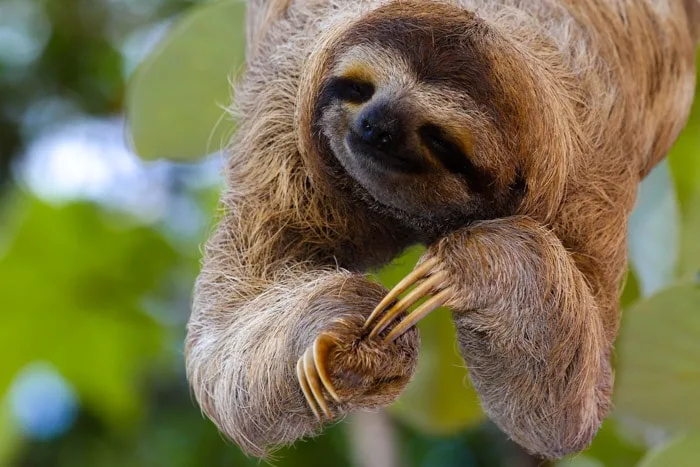
Also known as maned sloth, the three-toed sloth is the slowest mammal in the world. It moves through the canopy at a rate of about 40 yards (91 m) per day and spends 15 to 20 hours per day sleeping.
- Scientific name: Bradypus torquatus
- Class: Mammal
- Size and appearance: Head and body, 22 to 30 inches (55 to 75 cm); tail, 2 inches (5 cm). This friendly mammal has a pale brown to gray pelage covering dense, black, and white underfur.
- Weight: 9 to 22 pounds (4 to 10 kg).
- Lifespan in the wild: 12 to 15 years
- Conservation status: Vulnerable, meaning the maned three-toed sloth is at high risk of extinction in the wild, according to the IUCN Red List of Threatened Species.
- Threats: Ever-evolving agriculture, livestock farming, hunting, wood harvesting, and road traffic are the main reasons this animal is at high risk of extinction.
- Hunting and diet: The three-toed sloth feeds exclusively on tree and liana leaves, especially cecropia.
- Best places to see three-toed sloths: These animals native to Brazil are now only found in the Atlantic coastal rainforest of Brazil. Namely, in some parts of Rio de Janeiro, Espírito Santo, and in the Monte Pascoal National Park in Bahia.
22. Greater rhea
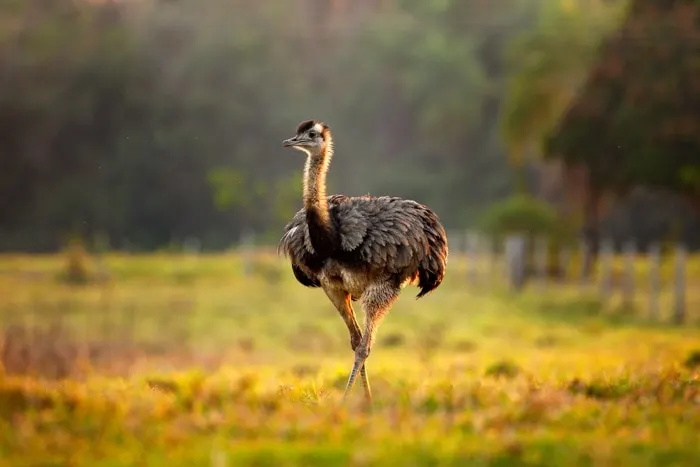
The largest bird in South America, the greater rhea is a flightless bird related to ostriches and emus.
- Scientific name: Rhea americana
- Class: Mammal
- Size and appearance: Beak to tail, 4.9 feet (150 cm); height, 4.6 to 5.6 feet (140 to 170 cm). They have small heads, and their legs are long. The wings are relatively long, and they have a fluffy, tattered-looking plumage that is brown or gray.
- Weight: 44 to 60 pounds (20 to 27 kg).
- Lifespan in the wild: 10 to 15 years
- Conservation status: Near threatened, meaning it is likely to become vulnerable soon, according to the IUCN Red List of Threatened Species.
- Threats: Livestock farming and hunting are threatening factors to the greater rhea.
- Hunting and diet: Their diet consists of foliage, seeds, fruit, insects, scorpions, fish, small rodents, reptiles, and little birds.
- Best places to see greater rhea: They inhabit the Brazilian cerrado, Pantanal, and Iguazu Falls.
23. Yacare caiman
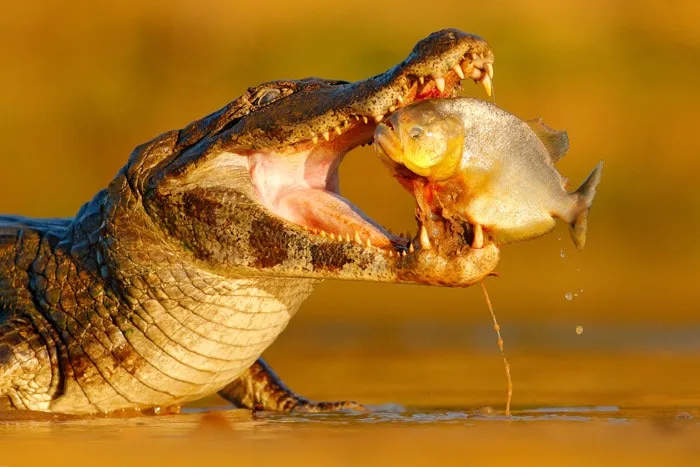
The Yacare caiman is an ancient creature that lives in central South America, about 10 million of them inhabiting the Brazilian Pantanal, possibly the world’s largest single crocodilian population.
- Scientific name: Caiman yacare
- Class: Reptile
- Size and appearance: Body and tail length, 5 to 9.8 feet (150 to 300 cm). These medium-sized caimans are brownish and have dark marks across the body. Some of the teeth on their lower jaw can poke through holes in the upper jaw. This feature makes their teeth more prominent, which have been compared to piranhas. Hence the common name “piranha caiman.”
- Weight: 31 to 128 pounds (14 to 58 kg).
- Lifespan in the wild: up to 50 years
- Conservation status: Least concerned, meaning the yacare caiman is at relatively low risk of extinction, according to the IUCN Red List of Threatened Species.
- Threats: Unknown.
- Hunting and diet: As carnivores, they mainly eat fish, especially piranhas, birds, reptiles, and small mammals.
- Best places to see yacare caiman: At least 10 million yacare caimans live in the Brazilian Pantanal, making it one of the largest Brazilian wildlife species in the region.
24. Brazil-nut poison frog
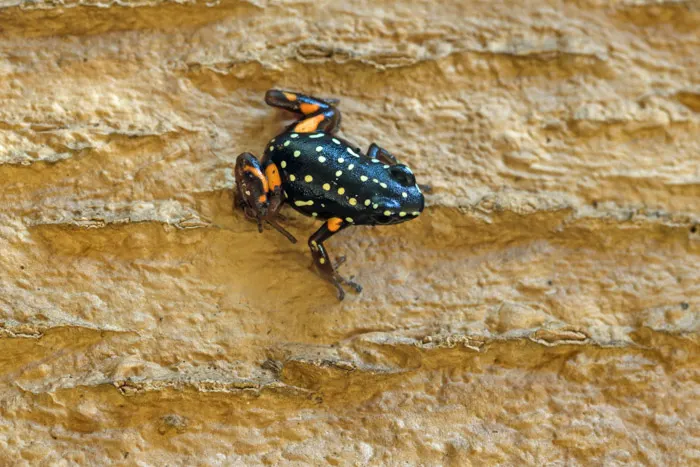
The Brazil-nut poison frog is among the smallest of the poison dart frogs, and its name comes from its tendency for depositing its tadpoles in the fruit capsules of brazil nut trees.
- Scientific name: Adelphobates castaneoticus
- Class: Amphibious
- Size and appearance: Head and body, 0.7 to 0.9 inches (18 to 23 mm). The body color is glossy black with white to yellow dots.
- Weight: 0.1 ounce (3 gr).
- Lifespan in the wild: 7 to 11 years
- Conservation status: Least concerned, meaning the yacare caiman is at relatively low risk of extinction, according to the IUCN Red List of Threatened Species.
- Threats: Overexploitation for pet trade, habitat destruction resulting from deforestation, and agriculture may ultimately reduce populations.
- Hunting and diet: These frogs are diurnal and insectivorous, feeding mostly on ants, termites, and other small invertebrates.
- Best places to see Brazil-nut poison frog: Remember: this animal is venomous, so do not approach it. Still, it occurs in the primary lowland forest near Cachoeira Juruá, Rio Xingu, and the Tapajos drainage at the State of Pará, Brazil.
25. Hyacinth macaw
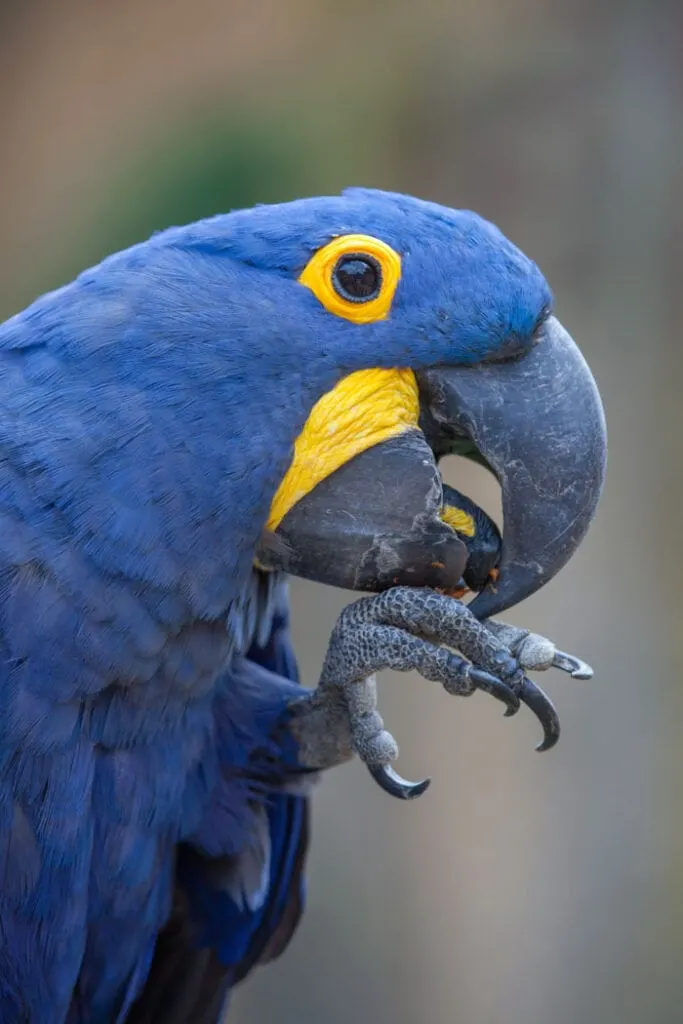
Hyacinth macaws are the world’s longest parrots and the largest flying parrot species.
- Scientific name: Anodorhynchus hyacinthinus
- Class: Bird
- Size and appearance: Body length, 39 inches (100 cm); wingspan, 51 to 59 inches (130 to 150 cm). The hyacinth macaw has impressive cobalt blue feathers, which contrast with their bare yellow eye-ring.
- Weight: 2.6 to 3.7 pounds (1,2 to 1,7 kg).
- Lifespan in the wild: 50 years
- Conservation status: Vulnerable, meaning the hyacinth macaw is at high risk of extinction in the wild, according to the IUCN Red List of Threatened Species.
- Threats: Ever-expanding lodging, agriculture, hunting, and trafficking are the main threats to the hyacinth macaws.
- Hunting and diet: These Brazilian birds usually eat nuts from acuri and bocaiuva palms, as well as a wide variety of seeds and tree fruits.
- Best places to see hyacinth macaws: These birds live in the Pantanal, Cerrado, and some parts of Pará State, eastern of the Amazon Basin.
26. Goliath birdeater
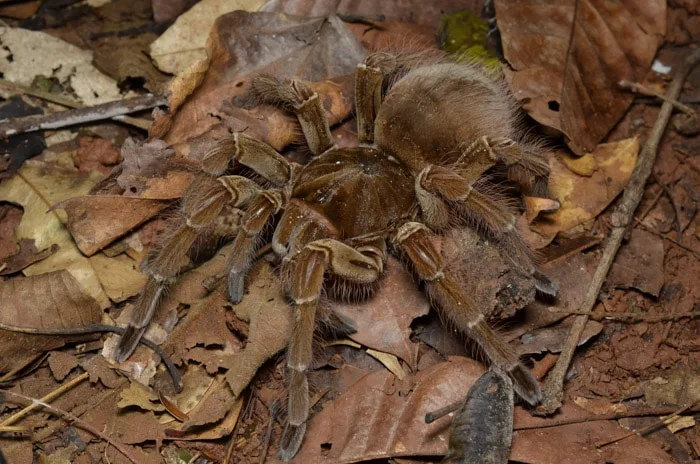
The goliath birdeater is the biggest spider on the planet. Some scientists call it the puppy spider as it is as big as a puppy.
- Scientific name: Theraphosa blondi
- Class: Arachnid
- Size and appearance: Body length, up to 5.1 inches (13 cm). They are mostly tan to light brown and golden-hued. They can have a leg span up to 12 inches (30 cm). They have large fangs (0.79 to 1.57 in/2 to 4 cm) and bite in self-defense, but their venom is relatively harmless to humans.
- Weight: 6.2 ounces (175 grams).
- Lifespan in the wild: 3 to 25 years
- Conservation status: Not evaluated.
- Threats: Unknown.
- Hunting and diet: Despite this spider’s name, they rarely prey on birds. Insects, frogs, and rodents are usually part of the menu. Before eating, the spider liquefy the prey’s inside, then they have their meal.
- Best places to see goliath birdeaters: Not that you would like to come closer to this tarantula (right?), but these massive spiders prowl the marshy and swampy areas in the Amazon Rainforest.
27. Rufous-bellied thrush – the national bird of Brazil
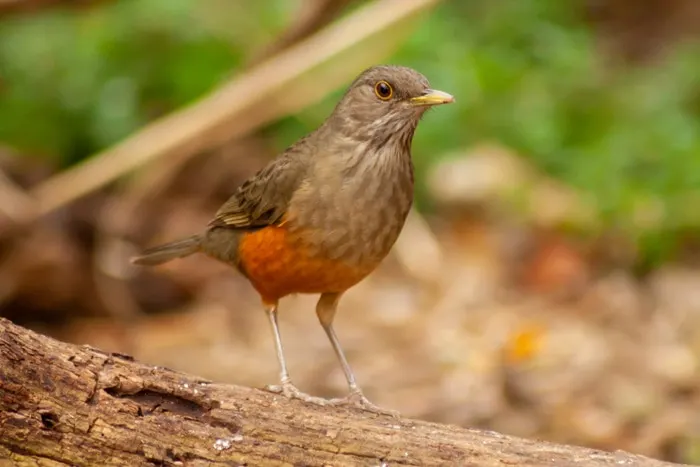
The rufous-bellied thrush is the national bird of Brazil since 2002[1], and it is highly regarded in the country.
Between August and November, thousands of birds sing during the night until sunrise, which is why it is seen as the Brazilian commoner’s spirit.
- Scientific name: Turdus rufiventris
- Class: Bird
- Size and appearance: Up to 10 inches (25 cm). As the name describes, this little Brazilian bird has a reddish-orange belly, while the rest of its body is brownish-gray.
- Weight: 2.4 to 2.7 ounces (68 to 78 gr).
- Lifespan in the wild: 25 to 30 years
- Conservation status: Least concerned, meaning the ocelot is at relatively low risk of extinction, according to the IUCN Red List of Threatened Species.
- Threats: Unknown.
- Hunting and diet: This omnivorous bird feeds from fruits and insects.
- Best places to see Rufous-bellied thrush: These southern birds are found in forests and urban wooded areas from the state of Rio Grande do Sul up to Maranhão.
28. Red-bellied piranha
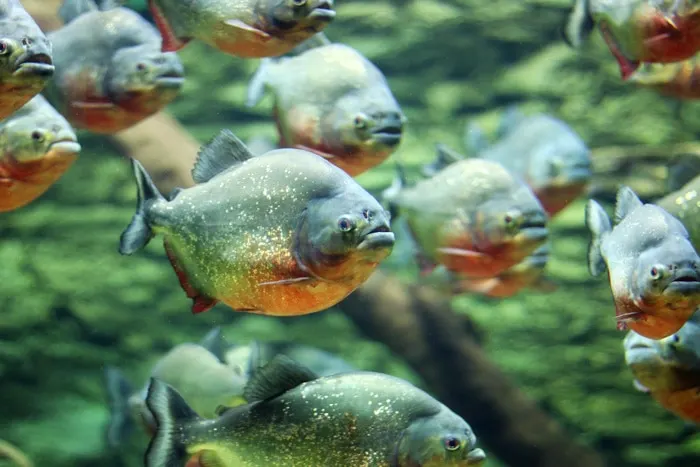
The piranha is a unique freshwater fish with an infamous reputation as a dangerous carnivore. However, it is usually harmless to humans. They also tend to only feed on weak, injured, or deceased animals in the wild.
So don’t worry, humans are not necessarily in their diet. If you ever fall into a river with this fish, they won’t recreate the scarry 1978 Piranha film scenes unless you’re injured.
- Scientific name: Pygocentrus nattereri
- Class: Actinopterygii
- Size and appearance: Up to 20 inches (50 cm) long. As the name says, this piranha has a red belly while the rest of the body is often gray with silver-flecked scales.
- Weight: Up to 8.6 pounds (3.9 kg)
- Lifespan in the wild: 10 years
- Conservation status: Not evaluated.
- Threats: Unknown.
- Hunting and diet: The typical diet of red-bellied piranhas includes insects, worms, crustaceans, and fish. In packs up to hundreds, piranhas have been known to feed on animals as large as egrets or capybara. Red-bellied piranhas do not stay in groups to pack-hunt for larger animals, but instead group for protection against predators.
- Best places to see piranhas: Piranhas are widely distributed throughout South America and can be found in the Pantanal and the rivers Amazon, Paraguay, Paraná, and Essequibo.
29. Green anaconda
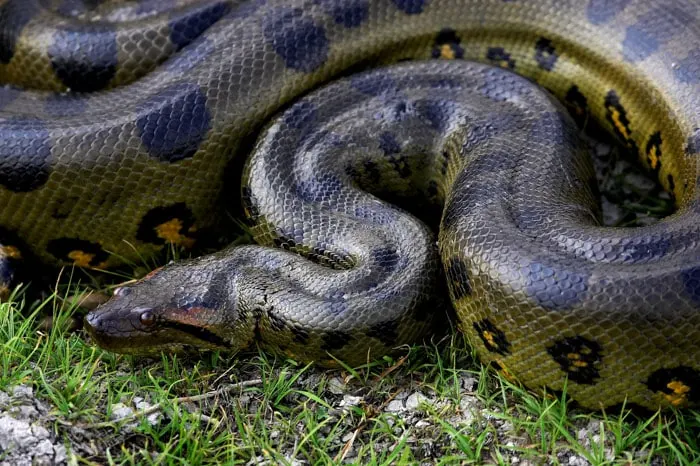
The green anaconda is the biggest snake in the world – not because it is exceptionally long, but because it is so heavy.
- Scientific name: Eunectes murinus
- Class: Reptile
- Size and appearance: Body length, 20 to 30 feet (6 to 9 m). The green anaconda is the world’s most giant snake hence why its top speed is only 10 mph/16 kph. This Brazilian animal is olive-green with black spots all over its body. Its head has orange-yellow stripes on both sides.
- Weight: 66 to 550 pounds (30 to 250 kg).
- Lifespan in the wild: 10 to 30 years
- Conservation status: Not evaluated.
- Threats: Unknown.
- Hunting and diet: Anacondas are apex predators that feed on other reptiles, sheep, capybaras, fish, birds, and any kind of prey they can catch and swallow. As with any boa constrictors, the anaconda is non-venomous, so it constricts the prey until at least unconscious before swallowing it whole.
- Best places to see green anacondas: Anacondas are frequently found in the Amazon Basin and the Brazilian Pantanal.
30. Jaguar
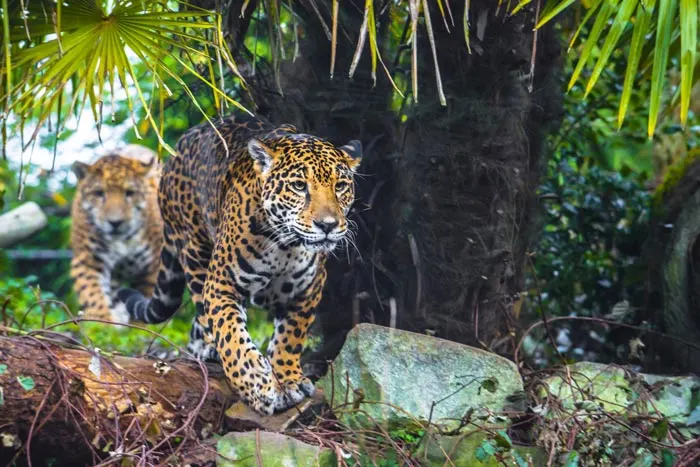
The jaguar is the largest cat native to the American continent and the third in the world. This big cat is often depicted as the national symbol of Brazil and is more easily found in the Amazon region.
- Scientific name: Panthera onca
- Class: Mammal
- Size and appearance: Head and body, 5 to 6 feet (152 to 180 cm); tail, 27 to 36 inches (69 to 91). As the third largest cat in the world, jaguars are incredibly agile. Their fur is tan to orange with black rosettes.
- Weight: 100 to 250 pounds (45 to 114 kg).
- Lifespan in the wild: 12 to 15 years
- Conservation status: Near threatened, meaning it is likely to become vulnerable shortly, according to the IUCN Red List of Threatened Species.
- Threats: Deforestation for pasture ensures their habitat destruction and modification, which leads to jaguar’s endangerment. Illegal killing is also rapidly decreasing its population. Lastly, forest fires are threatening the jaguar’s food supply.
- Hunting and diet: Unlike other cats, jaguars don’t avoid water. In fact, they are formidable swimmers. They are also good climbers and often climb trees to prepare for an ambush. As an apex predator, the jaguar is at the top of the food chain hence not preyed on by any other animal. They hunt fish, turtles, caimans, deers, capybaras, and several other land animals, which they prefer to ambush at night using their mighty jaws to pierce the animals’ skulls.
- Best places to see jaguars: Jaguars are typically found in tropical rainforests, savannas, and grasslands. Nowadays, their main stronghold is the Amazon Basin and the Brazilian Pantanal.
31. Bonus Brazilian animal: Brazilian Terrier

The Brazilian Terrier is the only domestic animal on this list. It is a medium-sized dog that can range in size depending on its genetic inheritance.
They have an elegant appearance and can be quite charming, fitting right into the pool of other Terriers. In Brazil, they are better known as Fox Paulistinha.
- Scientific name: Canis lupus familiaris
- Class: Mammal
- Size and appearance: About 13 to 16 inches (33 to 40 cm) tall. Brazilian Terriers are short and sleek. Their tricolor coat is white, tan, and black or brown, very similar to a Jack Russell Terrier.
- Weight: 14 to 22 pounds (6.3 to 10 kg).
- Lifespan: 12 to 14 years
- Conservation status: Least concern, meaning it has a relatively low risk of extinction.
- Threats: None.
- Hunting and diet: The Brazilian Terrier is a domestic animal, so like most pets, they eat dog food. Although they have a hunting instinct, these lovely dogs are 100% domesticated—nothing wild here.
- Best places to see Brazilian Terriers: Wander through popular parks and be alert to locals walking their dogs. 😉
Did you like this article about Brazil animals? Then share it with a friend who might like it too!

Jackie B.
Tuesday 21st of December 2021
This is a good informational site!